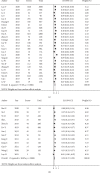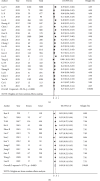The Correlation between Traditional Chinese Medicine Constitution and Hyperuricemia and Gout: A Systematic Review and Meta-Analysis
- PMID: 37101714
- PMCID: PMC10125745
- DOI: 10.1155/2023/5097490
The Correlation between Traditional Chinese Medicine Constitution and Hyperuricemia and Gout: A Systematic Review and Meta-Analysis
Abstract
Objective: To investigate the correlation between the constitution of traditional Chinese medicine (TCM) and hyperuricemia (HUA) and gout.
Method: Databases including China National Knowledge Infrastructure (CNKI), WanFang Data, China Science and Technology Journal Database (VIP), China Biology Medicine Disc (CBMdisc), PubMed, The Cochrane Library, Web of Science, and Excerpta Medical Database (Embase) were searched to collect observational studies about TCM constitution in HUA and gout from inception to November 21, 2021. The distribution of TCM constitution types in HUA and gout patients was presented by proportion, while the correlation was presented by odds ratio (OR) and 95% CI. Meta-analysis was performed using StataCorp Stata (STATA) version 16.0 software.
Results: Twenty-one cross-sectional studies and 10 case-control studies involving 38028 samples were included, among which 27526 patients were diagnosed with HUA and 2048 patients with gout. Phlegm-dampness constitution (PDC), damp-heat constitution (DHC), and qi-deficiency constitution (QDC) are the most common types, accounting for 24% (20%-27%), 22% (16%-27%), and 15% (12%-18%), respectively, in HUA patients, while DHC, PDC, and blood stasis constitution (BSC) accounted for 28% (18%-39%), 23% (17%-29%), and 11% (8%-15%), respectively, in gout patients. PDC and DHC were the main constitution types in patients with HUA or gout in south China, east China, north China, southwest China, northwest China, and northeast China. There was no difference in the distribution of PDC and QDC in male or female patients with HUA, while males with DHC in HUA were more common than females. The proportion of PDC or DHC among HUA patients was 1.93 times and 2.14 times higher than that in the general population (OR and 95% CI: 1.93 (1.27, 2.93), 2.14 (1.47, 3.13)), while the proportions of PDC, DHC, and BSC were 3.59 times, 4.85 times, and 4.35 times higher than that of the general groups (OR and 95% CI: 3.59 (1.65, 7.80), 4.85 (1.62, 14.57), and 4.35(2.33, 8.11)).
Conclusion: PDC, DHC, and QDC are the main constitution types of patients with HUA, while PDC and QDC may be the risk factors for HUA. DHC, PDC, and BSC are the main constitution types of patients with gout, and they may be the risk factors for gout. In clinical and scientific research, more attention should be paid to the relationship between the above-mentioned TCM constitution in HUA or gout. Nevertheless, because the quality of the included observational studies is low, more prospective cohort studies related to TCM constitution and HUA or gout can be carried out to verify the causality between TCM constitution and HUA or gout.
Copyright © 2023 Zihao Jiang et al.
Conflict of interest statement
The authors declare that they have no conflicts of interest related to the publication of this paper and have signed their consent for publishing the article.
Figures




Similar articles
-
Traditional Chinese Medicine Constitution Correlated with Ischemic Stroke: A Systematic Review and Meta-Analysis.Evid Based Complement Alternat Med. 2021 Jun 24;2021:5524925. doi: 10.1155/2021/5524925. eCollection 2021. Evid Based Complement Alternat Med. 2021. PMID: 34257683 Free PMC article. Review.
-
Traditional Chinese Medicine constitution types of high-normal blood pressure: A meta-analysis.Heliyon. 2023 Feb 6;9(2):e13438. doi: 10.1016/j.heliyon.2023.e13438. eCollection 2023 Feb. Heliyon. 2023. PMID: 36825189 Free PMC article.
-
The correlation between traditional Chinese medicine constitution and primary osteoporosis: A systematic review and meta-analysis.Medicine (Baltimore). 2024 Sep 13;103(37):e39560. doi: 10.1097/MD.0000000000039560. Medicine (Baltimore). 2024. PMID: 39287293 Free PMC article.
-
Clinical research linking Traditional Chinese Medicine constitution types with diseases: a literature review of 1639 observational studies.J Tradit Chin Med. 2020 Aug;40(4):690-702. doi: 10.19852/j.cnki.jtcm.2020.04.019. J Tradit Chin Med. 2020. PMID: 32744037 Review.
-
Correlation between Traditional Chinese Medicine Constitution and Dyslipidemia: A Systematic Review and Meta-Analysis.Evid Based Complement Alternat Med. 2017;2017:1896746. doi: 10.1155/2017/1896746. Epub 2017 Oct 22. Evid Based Complement Alternat Med. 2017. PMID: 29234371 Free PMC article. Review.
Cited by
-
Correlation Analysis of Traditional Chinese Medicine Constitution and Metabolic Indexes in General Physical Examination People.Endocr Metab Immune Disord Drug Targets. 2025;25(7):560-568. doi: 10.2174/0118715303302433240918104124. Endocr Metab Immune Disord Drug Targets. 2025. PMID: 39364874
References
-
- Chinese Society of Endocrinology. Guideline for diagnosios andmanagement of hyperuricemia and gout in China(2019) Chinese Journal of Endocrinology and Metabolism . 2020;36(1):1–13.
-
- Yanai H., Adachi H., Hakoshima M., Katsuyama H. Molecular biological and clinical understanding of the pathophysiology and treatments of hyperuricemia and its association with metabolic syndrome, cardiovascular diseases and chronic kidney disease. International Journal of Molecular Sciences . 2021;22(17):p. 9221. doi: 10.3390/ijms22179221. - DOI - PMC - PubMed
Publication types
LinkOut - more resources
Full Text Sources

